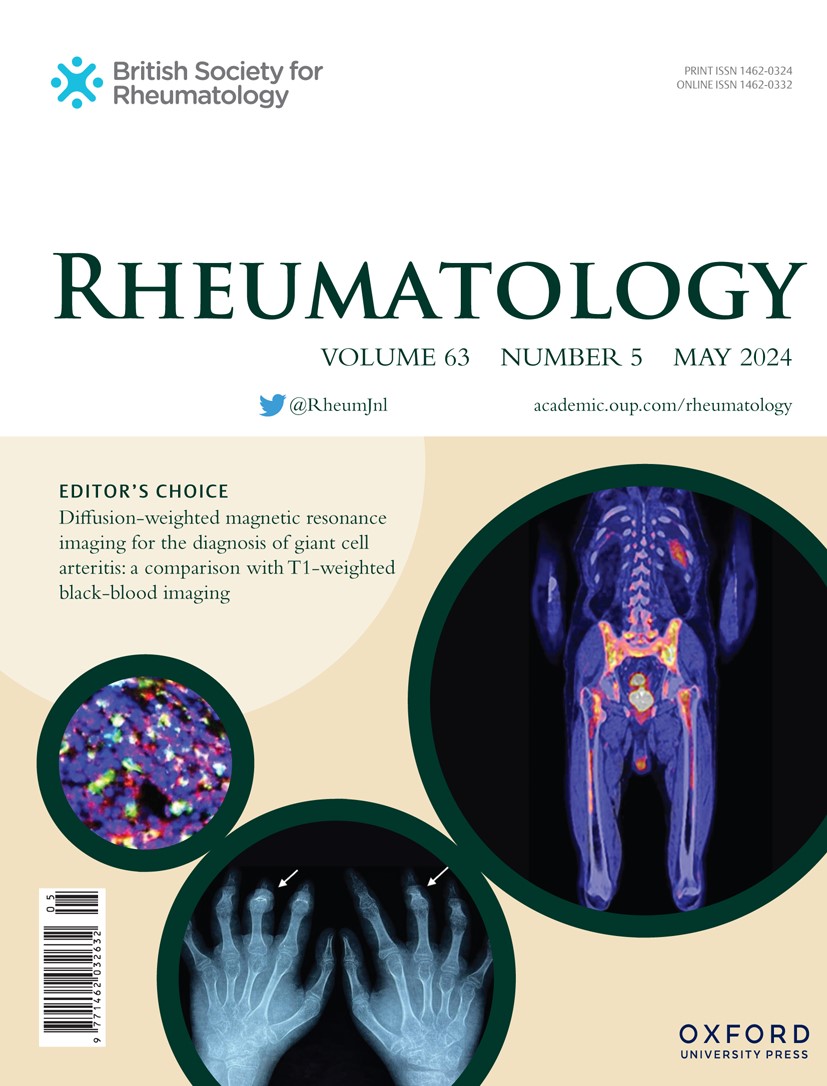P178 Use of a musculoskeletal ultrasound (MSK US) protocol for the initial assessment of patients with suspected psoriatic arthritis (PsA): results of a service improvement project
IF 4.7
2区 医学
Q1 RHEUMATOLOGY
引用次数: 0
Abstract
Background/Aims MSK US changes in PsA are well recognised. We initially conducted a literature review to summarise the research in MSK US use in PsA, and its value in assessing its diagnosis in patients with skin psoriasis (PsO). This informed the development of a standard US protocol for screening patients with PsO and arthralgia at their first presentation to rheumatology clinic as part of a service improvement project. We aimed to assess the potential role of US in the assessment and triage of PsA referrals. Methods Consecutive patients referred with possible PsA across Newcastle and Northumbria Trusts were booked into dedicated appointments. All had personal history of PsO without previous PsA diagnosis. Patients were reviewed independently by 2 clinicians: initially for protocolised ultrasound scan and separately for clinical assessment, see Figure 1. Ultrasonographic entheseal grading was used, as specified by GRAPPA. Both clinicians documented the likelihood of PsA diagnosis. Subsequently, clinical judgements were reviewed in the context of the US findings. Results 41 patients were scanned (Figure 1); 14 male and 27 female. Mean age 49.9 years, PASI score 3.0, ultrasound duration 26.7 minutes. In the majority, clinical and ultrasound outcomes matched. 30/41 patients showed no concern of PsA after dual ultrasound and clinical assessment and were discharged. On clinical examination, 15/41 had entheseal tenderness on palpation. On US, only 2 of these had consistent ultrasound changes. 6 patients were diagnosed with PsA, and in each clinical and ultrasound outcomes matched. Of these 6, 4 had knee synovitis, and 3 had ankle involvement (2 with effusion with synovial hypertrophy; 1 tibialis posterior tenosynovitis). Conclusion Screening tests for PsA such as PEST can result in high numbers of referrals with low yield of PsA diagnosis. It can be difficult to exclude PsA clinically in those with PsO and arthralgia, especially when entheseal or joint tenderness is present. We have demonstrated that a protocolised MSK US scan can help to differentiate patients with active inflammation who need prompt assessment and treatment, and those who do not and can be safely discharged. This has the potential to streamline referral routes for these patients. Disclosure K. Khokhar: Honoraria; KK has received conference sponsorship from UCB.. Grants/research support; This work formed part of a post-CCT Rheumatology Ultrasound Fellowship hosted by Newcastle and Northumbria Foundation Trusts. Novartis funded the salary and training costs of the Fellow (KK). I. Atchia: Consultancies; IA has received consultancy fees/advisory board from Abbvie. Honoraria; IA has received conference sponsorship from UCB, Eli Lilly and Novartis. B. Thompson: Honoraria; BT has received honoraria/travel support from Abbvie, Chugai, Janssen, Lilly, Novartis and UCB.P178使用肌肉骨骼超声(MSK US)方案对疑似银屑病关节炎(PsA)患者进行初步评估:服务改进项目的结果
背景/目的MSK US的PsA变化是公认的。我们首先进行了一项文献综述,以总结MSK US在PsA中的应用研究,以及其在评估皮肤牛皮癣(PsO)患者诊断中的价值。这为美国标准方案的制定提供了信息,用于在风湿病诊所首次就诊时筛查PsO和关节痛患者,作为服务改进项目的一部分。我们的目的是评估US在PsA转诊的评估和分诊中的潜在作用。方法在纽卡斯尔和诺森布里亚信托基金连续转诊可能患有PsA的患者进行专门预约。所有患者均有PsO病史,既往无PsA诊断。患者由2名临床医生独立审查:最初进行协议超声扫描,单独进行临床评估,见图1。根据GRAPPA的规定,采用超声对肺组织进行分级。两位临床医生都记录了PsA诊断的可能性。随后,在美国研究结果的背景下对临床判断进行了审查。结果扫描41例患者(图1);14男27女。平均年龄49.9岁,PASI评分3.0分,超声时间26.7分钟。在大多数情况下,临床结果和超声结果相符。30/41例患者经双超声及临床评估无PsA症状,出院。临床检查,15/41触诊有肠末压痛。在超声检查中,仅有2例患者超声改变一致。6例患者被诊断为PsA,临床结果与超声结果相符。在这6例患者中,4例有膝关节滑膜炎,3例有踝关节受累(2例有滑膜肥厚积液;1 .胫骨后腱滑膜炎。结论PsA筛查试验如PEST可导致大量转诊而PsA诊断率低。在临床上,PsO和关节痛患者很难排除PsA,特别是当骨膜或关节压痛存在时。我们已经证明,协议化的MSK US扫描可以帮助区分需要及时评估和治疗的活动性炎症患者,以及不需要并且可以安全出院的患者。这有可能简化这些患者的转诊路线。K. Khokhar:酬金;KK获得UCB会议赞助。授予/研究支持;这项工作是由纽卡斯尔和诺森比亚基金会信托基金主办的后cct风湿病超声奖学金的一部分。诺华公司为该研究员(KK)提供工资和培训费用。一、附件:咨询;IA已收到艾伯维的顾问费/顾问委员会。酬金;IA获得了UCB, Eli Lilly和Novartis的会议赞助。B.汤普森:荣誉;英国电信获得了艾伯维、Chugai、杨森、礼来、诺华和UCB的酬金/差旅支持。
本文章由计算机程序翻译,如有差异,请以英文原文为准。
求助全文
约1分钟内获得全文
求助全文
来源期刊

Rheumatology
医学-风湿病学
CiteScore
9.40
自引率
7.30%
发文量
1091
审稿时长
2 months
期刊介绍:
Rheumatology strives to support research and discovery by publishing the highest quality original scientific papers with a focus on basic, clinical and translational research. The journal’s subject areas cover a wide range of paediatric and adult rheumatological conditions from an international perspective. It is an official journal of the British Society for Rheumatology, published by Oxford University Press.
Rheumatology publishes original articles, reviews, editorials, guidelines, concise reports, meta-analyses, original case reports, clinical vignettes, letters and matters arising from published material. The journal takes pride in serving the global rheumatology community, with a focus on high societal impact in the form of podcasts, videos and extended social media presence, and utilizing metrics such as Altmetric. Keep up to date by following the journal on Twitter @RheumJnl.
 求助内容:
求助内容: 应助结果提醒方式:
应助结果提醒方式:


